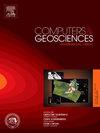Quadrangular adaptive mesh for elastic wave simulation in smooth anisotropic media
IF 4.4
2区 地球科学
Q1 COMPUTER SCIENCE, INTERDISCIPLINARY APPLICATIONS
引用次数: 0
Abstract
Smooth anisotropic media are often met when implementing effective medium theory, full waveform inversion or seismic imaging. However, computational overburden is often a recurring problem when working with high frequencies or when quantifying uncertainties. In this context, adaptive meshes constitute, in principle, an attractive representation to maximize simulation accuracy while minimizing the computational cost. However, such meshes are difficult to create in the context of smooth anisotropic media as the optimal local size of the elements is not clearly defined. In this work, we present a two-step algorithm to efficiently mesh these media for spectral element method (SEM) simulation in the 2D elastic case. Our algorithm yields quadrangular only meshes which adapt the size of the element to the local and directional S-wave velocity. It relies on a quadtree division introduced by Maréchal (2009) to divide the mesh until the size of each element edge is adapted to the local minimum wavelength that will be propagated. Then, a Laplacian smoothing is applied to further optimize the size of the elements, increasing the global time step and makes the SEM simulation faster while keeping a good accuracy and even improving it in some cases. An application of our method on a 2D section of the homogenized Groningen area shows that simulation time can be reduced by a factor up to 7.
光滑各向异性介质弹性波模拟的四边形自适应网格
在进行有效介质理论、全波形反演或地震成像时,往往会遇到光滑的各向异性介质。然而,在处理高频或量化不确定性时,计算覆盖常常是一个反复出现的问题。在这种情况下,自适应网格在原则上构成了一种有吸引力的表示,以最大化模拟精度,同时最小化计算成本。然而,在光滑的各向异性介质中,由于单元的最佳局部尺寸没有明确定义,这种网格很难创建。在这项工作中,我们提出了一种两步算法来有效地网格化这些介质,以便在二维弹性情况下进行谱元法(SEM)模拟。我们的算法只产生四边形网格,使单元的大小适应局部和定向s波速度。它依靠marsamchal(2009)引入的四叉树划分来划分网格,直到每个元素边缘的大小适应将被传播的局部最小波长。然后,应用拉普拉斯平滑进一步优化单元的大小,增加全局时间步长,使SEM模拟速度更快,同时保持良好的精度,甚至在某些情况下提高精度。将该方法应用于均匀化格罗宁根区域的二维截面上,结果表明,模拟时间最多可减少7倍。
本文章由计算机程序翻译,如有差异,请以英文原文为准。
求助全文
约1分钟内获得全文
求助全文
来源期刊

Computers & Geosciences
地学-地球科学综合
CiteScore
9.30
自引率
6.80%
发文量
164
审稿时长
3.4 months
期刊介绍:
Computers & Geosciences publishes high impact, original research at the interface between Computer Sciences and Geosciences. Publications should apply modern computer science paradigms, whether computational or informatics-based, to address problems in the geosciences.
 求助内容:
求助内容: 应助结果提醒方式:
应助结果提醒方式:


